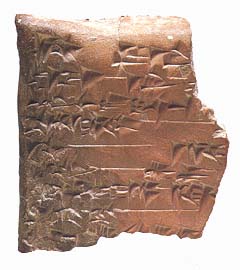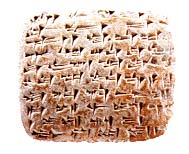Cuneiform Tablets from Hazor
In the 1960s a youngster stumbled across a small piece of a broken tablet at Hazor. The cuneiform text impressed into the clay proved to be part of an ancient foreign language dictionary—translating terms from Akkadian, the diplomatic lingua franca of the eastern Mediterranean world in the Middle and Late Bronze Ages, into Sumerian. The terms are economic- “rate of exchange,” “market rate,” “price.” Presumably, a learned scribe at Hazor created the dictionary to help his students or colleagues translate and write complex texts concerning trade. The discovery of the tablet suggests that the king of Hazor once had a school of scribes who helped with his foreign correspondence.
Until the discovery of this tablet, our evidence of writings from Hazor came from the correspondence found in the 18th-century B.C.E. royal archive of Mari, on the Euphrates, and the 14th-century B.C.E. archive of Pharaoh Akhenaten, discovered in Tell el-Amarna and called the Amarna letters. With the accidental discovery of this and one other tablet at Hazor, excavator Yigael Yadin became increasingly confident that he would unearth a royal archive in the site’s palace. “I will go back to Hazor,” Yigael Yadin told BAR just a year before his death, “and I think that I will find an archive there.”
Decades later, and after nine seasons of renewed excavations, we have yet to locate the archive or archives, which we emphatically believe still exist. Almost every year we discover more evidence of the work performed by the scribes of ancient Hazor.
We now possess eight tablets found at Hazor. Unfortunately, not one was discovered in situ; the dictionary tablet, for example, was found in a dump where dirt from earlier excavations had been discarded.
Nevertheless, each tablet offers intimate details about life, work and trade in ancient Hazor. The fragmentary inscriptions are often tantalizingly brief. One tablet (lower photo) begins “To Ibni … ,” but the full name is broken off. Could this be Ibni-Addu, the 18th-century B.C.E. king of Hazor known from the Mari archive?
Six of the tablets date to the Old Babylonian period, that is, to the period of close relations between Hazor and Mari. The paleography (shape and form of the letters), orthography (spelling) and onomasticon (personal names used) of these tablets, all of which are written in Akkadian, have their closest parallels in the Mari tablets.
One of the tablets mentions a trial in the court at Hazor, with the king present, in which a local woman won a real estate case that was brought against her. Like the dictionary tablet, this tablet, too, was not excavated but was discovered by a visitor to the site—22-year-old Jesse Salsberg, a New Yorker who was then honeymooning in Israel.14 Three of these tablets deal with economic matters- One is a long list of goods, including textiles, gold, silver and copper, that were to be sent from Hazor to Mari. A second economic text is a payroll document recording the names of 19 workers—probably Hazorites—who received payments, ranging (in the part that is preserved) from one-third to one-half shekel, for services rendered, most probably to the court.
The names mentioned in this and other tablets from Hazor indicate the languages spoken by the people, their possible places of origin and their most important deities. (The divine names are incorporated in personal names as theophoric elements.) Semitic names are naturally most common in the tablets. Most incorporate the divine element Addu, for the Canaanite storm god Hadad, as in Isûput-Addu and Habdadu. But we also see Isûhme-El, Hinni-El (El was the head of the Canaanite pantheon) and Abi-Erah (Erah was the moon god). Among the non-Semitic names are Purratpurta and Purridi, which are probably Indo-European names.
Further evidence of a scribal school comes from a mathematical tablet bearing multiplication tables- 2 × 30 = 60, 3 × 20 = 60, 4 × 15 = 60, etc. The sexagesimal system demonstrated here reminds us of the measurements, all divisible by 60, used in the construction of the Hazor palace.
In 1996, we discovered two tablets that exhibit the same grammatical and orthographical characteristics as the Canaanite documents in the Amarna archive, which date from the 14th century B.C.E. One of the tablets (upper photo) is a personal letter dealing with a civic dispute, the nature of which is not entirely clear. The text includes a standard introduction and several blessings also found in the 14th-century B.C.E. Amarna documents. Only three lines remain of the other tablet, an economic text that lists several cities, including Hazor, which is spelled URU, or Ha-s\uŒ-ra, as it is in the Amarna letters.
We hope that these tablets from the Middle Bronze Age and the Late Bronze Age mean we are on the right track as we continue our search for the palace archive.15 Perhaps not just one—but two—archives await our discovery.
Amnon Ben-Tor and Maria Teresa Rubiato, “Voices from Hazor,” BAR 25-03, May-Jun 1999.
See also-





